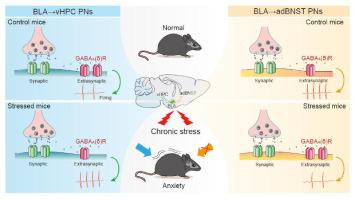Science Bulletin ( IF 18.9 ) Pub Date : 2021-09-16 , DOI: 10.1016/j.scib.2021.09.007 Xia Qin 1 , Han-Qing Pan 2 , Shou-He Huang 2 , Jia-Xin Zou 2 , Zhi-Heng Zheng 2 , Xiao-Xuan Liu 2 , Wen-Jie You 2 , Zhi-Peng Liu 2 , Jun-Li Cao 3 , Wen-Hua Zhang 4 , Bing-Xing Pan 5

|
Dysregulated GABAergic inhibition in the amygdala has long been implicated in stress-related neuropsychiatric disorders. However, the molecular and circuit mechanisms underlying the dysregulation remain elusive. Here, by using a mouse model of chronic social defeat stress (CSDS), we observed that the dysregulation varied drastically across individual projection neurons (PNs) in the basolateral amygdala (BLA), one of the kernel amygdala subregions critical for stress coping. While persistently reducing the extrasynaptic GABAA receptor (GABAAR)-mediated tonic current in the BLA PNs projecting to the ventral hippocampus (BLA → vHPC PNs), CSDS increased the current in those projecting to the anterodorsal bed nucleus of stria terminalis (BLA → adBNST PNs), suggesting projection-based dysregulation of tonic inhibition in BLA PNs by CSDS. Transcriptional and electrophysiological analysis revealed that the opposite CSDS influences were mediated by loss- and gain-of-function of δ-containing GABAARs (GABAA(δ)Rs) in BLA → vHPC and BLA → adBNST PNs, respectively. Importantly, it was the lost inhibition in the former population but not the augmentation in the latter population that correlated with the increased anxiety-like behavior in CSDS mice. Virally mediated maintenance of GABAA(δ)R currents in BLA → vHPC PNs occluded CSDS-induced anxiety-like behavior. These findings clarify the molecular substrate for the dysregulated GABAergic inhibition in amygdala circuits for stress-associated psychopathology.
中文翻译:

杏仁核-海马回路中的 GABAA(δ) 受体功能减退是应激性焦虑的基础
长期以来,杏仁核中失调的 GABA 能抑制一直与压力相关的神经精神疾病有关。然而,失调背后的分子和电路机制仍然难以捉摸。在这里,通过使用慢性社交失败压力 (CSDS) 的小鼠模型,我们观察到基底外侧杏仁核 (BLA) 中单个投射神经元 (PN) 的失调变化很大,基底外侧杏仁核是对压力应对至关重要的核杏仁核亚区之一。在持续减少突触外 GABA A受体(GABA AR) 介导的 BLA PNs 投射到腹侧海马体(BLA → vHPC PNs)中的强直电流,CSDS 增加了投射到纹状体前背床核(BLA → adBNST PNs)的电流,表明基于投射的失调CSDS 对 BLA PN 的强直抑制。转录和电生理分析表明,相反的 CSDS 影响分别由BLA → vHPC 和 BLA → adBNST PN 中含 δ 的 GABA A Rs (GABA A (δ)Rs) 的功能丧失和获得介导。重要的是,与 CSDS 小鼠中焦虑样行为增加相关的是前者群体中抑制的丧失而非后者群体中抑制的增强。病毒介导的 GABA A维持BLA → vHPC PN 中的 (δ)R 电流阻断了 CSDS 诱导的焦虑样行为。这些发现阐明了压力相关精神病理学杏仁核回路中 GABA 能抑制失调的分子底物。


























 京公网安备 11010802027423号
京公网安备 11010802027423号